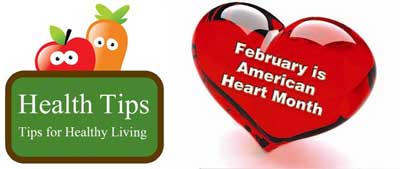
FEBRUARY IS HEALTHY HEART MONTH
Every year, Americans suffer more than 1.5 million heart attacks and strokes.
Every day, 2,200 people die from cardiovascular disease—that’s nearly 800,000 Americans each year, or 1 in every 3 deaths.
Together, heart disease and stroke are among the most widespread and costly health problems facing the nation today, accounting for more than $312.6 billion in health care expenditures and lost productivity annually—and these costs are rising. On a personal level, families who experience heart disease or stroke not only have to deal with medical bills but also lost wages and the real potential of a decreased standard of living.
We're all at risk for heart disease and stroke. People of all ages, genders, races, and ethnicities are affected. However, certain groups — including African Americans and older individuals are at higher than others.
Nearly half of all African American adults have some form of cardiovascular disease that includes heart disease and stroke.
High blood pressure is the leading cause of heart attack and stroke in the United States. About two out of every five African American adults have high blood pressure, and less than half of them have it under control. African American adults are much more likely to suffer from high blood pressure (hypertension), and heart attack and stroke deaths than white adults. Individuals living below the federal poverty level are more likely to have high blood pressure compared with those living at the highest level of income.
You can make healthy changes to lower your risk of developing heart disease. Controlling and preventing risk factors is also important for people who already have heart disease. To lower your risk:
- Watch your weight.
- Quit smoking and stay away from secondhand smoke.
- Control your cholesterol and blood pressure.
- If you drink alcohol, drink only in moderation.
- Get active and eat healthy.
Another strategy being encouraged by the Million Hearts initiative is to follow the ABCS. You can reduce your risk and improve your heart health by following the ABCS:
A: Take aspirin as directed by your health care provider.
B: Control your blood pressure.
C: Manage your cholesterol.
S: Don´t smoke.
More information targeted toward women...
Heart disease is the leading cause of death for women in the United States. February is American Heart Month. On National Wear Red Day, Friday, February 6, 2015, help raise awareness about heart disease in women.
Get Informed: Facts on Women and Heart Disease
Heart disease is the leading cause of death for women in the United States, killing nearly 422,000 each year.
Although heart disease is sometimes thought of as a "man's disease," around the same number of women and men die each year of heart disease in the United States. Following a heart attack, approximately 1 in 4 women will die within the first year, compared to 1 in 5 men.
Some conditions and lifestyle choices increase a person's chance for heart disease, including diabetes, overweight and obesity, poor diet, physical inactivity, and excessive alcohol use. Among women, black women are at highest risk of dying early from heart disease and stroke followed by American Indian/Alaska Native, White, Hispanic, and Asian/Pacific Islander women. High blood pressure, high LDL cholesterol, and smoking are key risk factors for heart disease. Lowering your blood pressure and cholesterol and not smoking will reduce your chances for heart disease.
Symptoms
While some women have no symptoms of heart disease, others may experience heavy sharp chest pain or discomfort, pain in the neck/jaw/throat, or pain in the upper abdomen or back. Sometimes heart disease may be silent and not diagnosed until a woman has signs or symptoms including:
- Heart Attack: Chest pain or discomfort, upper back pain, indigestion, heartburn, nausea/vomiting, extreme fatigue, upper body discomfort, and shortness of breath.
- Arrhythmia: Fluttering feelings in the chest (palpitations).
- Heart Failure: Shortness of breath, fatigue, swelling of the feet/ankles/legs/abdomen.
- Stroke: Sudden weakness, paralysis (inability to move) or numbness of the face/arms/legs, especially on one side of the body. Other symptoms may include: confusion, trouble speaking or understanding speech, difficulty seeing in one or both eyes, shortness of breath, dizziness, loss of balance or coordination, loss of consciousness, or sudden and severe headache.
Healthy Hearts
You can lower your chance of heart disease and heart attack by taking simple steps.
- Eat a healthy diet.
- Maintain a healthy weight.
- Be active. Exercise regularly.
- Be smoke-free. If you are ready to quit, call 1-800-QUIT-NOW (1-800-784-8669) or 1-855-DÉJELO-YA (1-855-335-3569 for Spanish speakers) for free resources, including free quit coaching, a free quit plan, free educational materials, and referrals to other resources where you live.
- Limit alcohol use. See your health care provider for a checkup, especially if you have any risk factors or symptoms.
- Talk to your health care provider and ask questions to better understand your health.
- Know your family history. There may be factors that could increase your risk for heart disease and stroke
Finally, to learn more ways to keep your heart healthy, please join us on Saturday, February 20, from 10:30am to 12 Noon in the Family Life Center Johnson Dance Studio for the Hypertension and Heart Disease workshop, facilitated by Elmarie Botha, from Samuel Merritt University.


